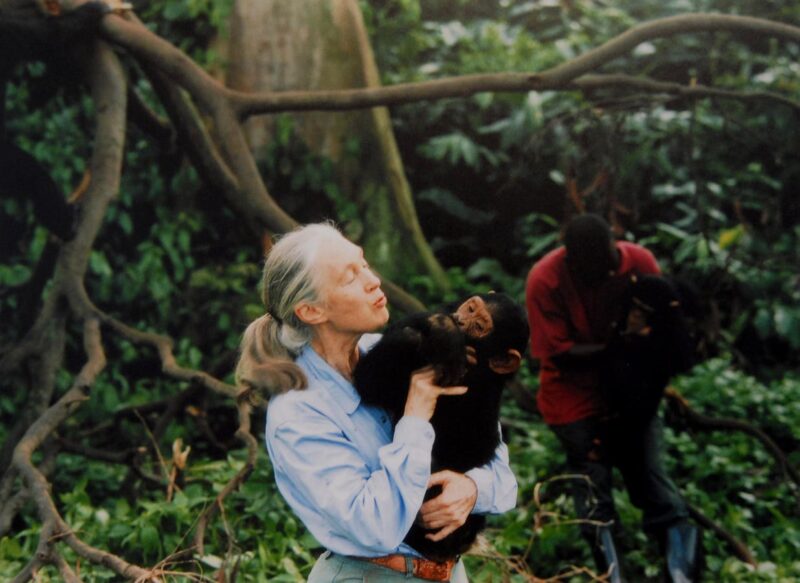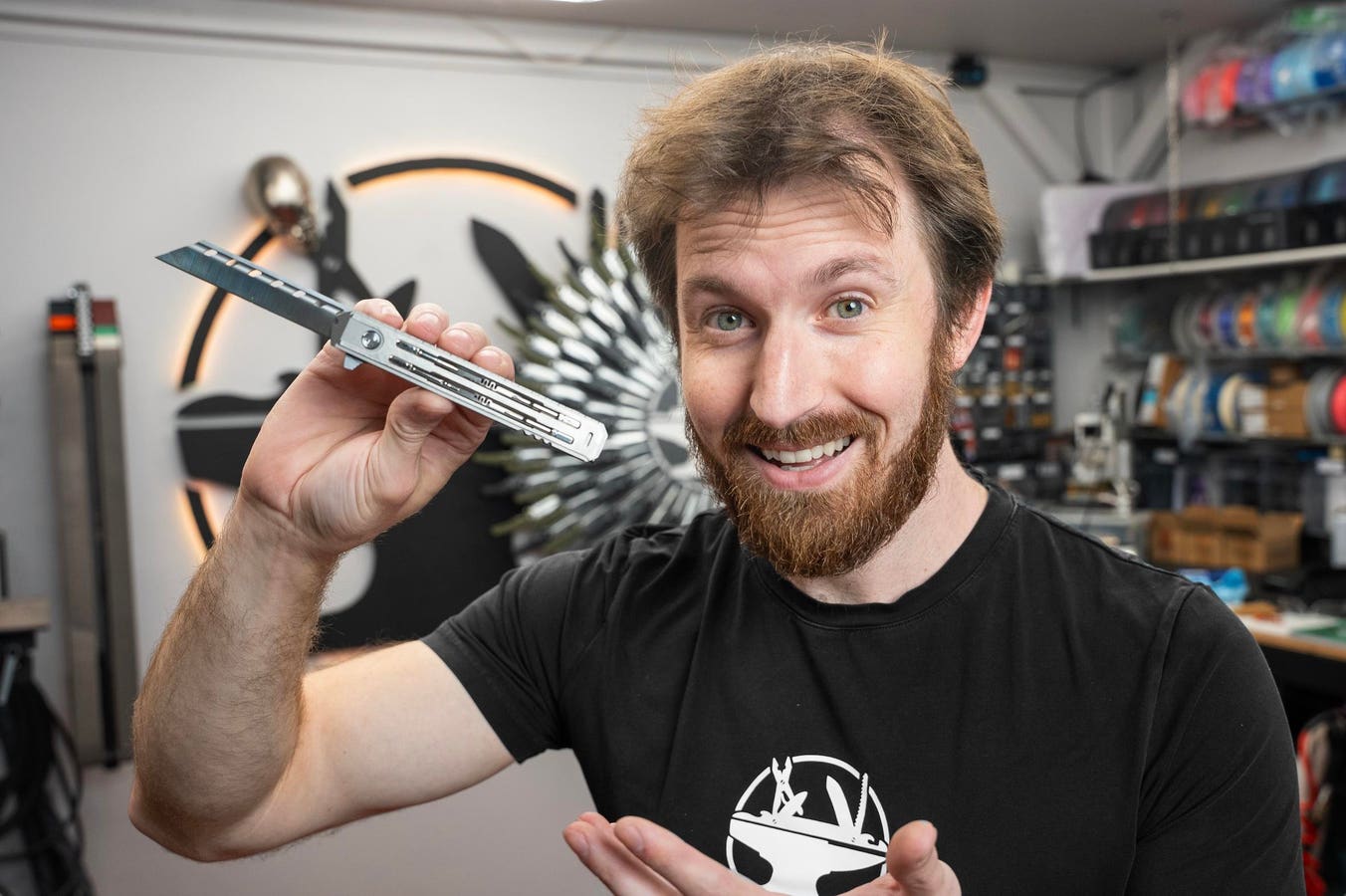The world is a poorer place without primatologist and conservation activist Jane Goodall, but it’s a richer place thanks to her work.
UNSPECIFIED : Jane Goodall, English primatologist, ethologist, and anthropologist, with a chimpanzee in her arms, c. 1995 (Photo by Apic/Getty Images)
Getty Images
During her 65-year career, Goodall rewrote everything mid-20th-century science thought it knew about animal behavior and intelligence. Her work shed new light on the lives, behavior, and inner worlds of humanity’s closest relatives. Goodall died at the age of 91 on October 1, 2025, during a speaking tour in the United States. Here are some things you might not know about the world-famous scientist and her work.
1. Jane Goodall Worked Closely With Famous Paleoanthropologists Louis and Mary Leakey
The Leakeys had spent years looking for a primate behavior researcher to help them better understand how extinct hominins (like the ones whose fossils and stone tools they were unearthing at Olduvai Gorge in Tanzania) lived. They wanted to know more about how very early hominins, with slightly different brains from modern humans, might have interacted with each other, organized themselves into social groups, and shared knowledge. And they thought living apes, like chimpanzees, could shed some light on the subject. After a decade of searching, the Leakeys found Jane Goodall and helped fund her first research trip to Tanzania’s Gombe National Park (then called Gombe Stream National Park) in 1960. Today, paleoanthropologists who study human evolution still look to chimpanzees and other living apes to answer some questions about aspect of early hominins’ lives.
2. When Jane Goodall Began Her Fieldwork, She Didn’t Have A Science Degree (Yet)
KIGOMA – DECEMBER 22: Jane Goodall appears in the television special “Miss Goodall and the World of Chimpanzees” originally broadcast on CBS, Wednesday, December 22, 1965. Location, Gombe Stream National Park, Tanzania. (Photo by CBS via Getty Images)
CBS via Getty Images
Two years later, in 1962, she became one of just a handful of people ever to start a PhD program at Cambridge University without an undergraduate degree. She zipped through her BA in natural sciences in just 2 years and finished her doctorate in 1966, based on her work at Gombe. Louis and Mary Leakey helped fund her doctoral studies.
3. Jane Goodall Was A Dog Person
Goodall is best known for the years she spent studying chimpanzees, and it’s clear that she loved them even when they showed their dark sides. But she admitted in a 2015 video interview that dogs are her favorite animal.
“Dogs have taught me so much,” said Goodall, “and are so faithful and give unconditional love, and I don’t like to think of a world without dogs.”
Her interest in animal intelligence and behavior was sparked by her childhood canine companion, Rusty. Rusty technically belonged to a hotel near the Goodalls’ home, but he roamed the neighborhood freely and spend most of his time with young Jane.
4. Jane Goodall Discovered That Animals Make And Use Tools
041816 01: Scientist Jane Goodall studies the behavior of a chimpanzee during her research February 15, 1987 in Tanzania. (Photo by Penelope Breese/Liaison)
Getty Images
During Goodall’s first field season at Gombe in 1960, she watched a friendly male chimpanzee named David Greybeard crouching over a termite mound and poking stalks of grass into the termite holes. When Greybeard pulled the grass out, it was covered with termites: a snack on a stick. Goodall noticed Greybeard and other chimps stripping leaves from small twigs to make even more efficient “termite fishing” poles. That sounds rudimentary, but it’s a pretty short step from stripping leaves off a twig to sharpening a stick for digging or throwing.
“I had to see it about four times before I let Louis Leakey know, and then I sent a telegram,” recalled Goodall decades later. Leakey replied, “We must now redefine man, redefine tool, or accept chimpanzees as human.”
At the time, most scientists thought of making tools as something only humans did, but Goodall proved otherwise. And in the years since Goodall first published her observations of chimpanzees carefully shaping termite sticks, scientists around the world have observed other animals, from monkeys to elephants and octopuses, using tools of their own; New Caledonian crows even carefully shape forked twigs into hooks for catching larvae. Some archaeologists even study tools made by animals.
5. Jane Goodall Was A Bigfoot Fan
When an NPR caller asked if she believed in “any undiscovered large ape species,” Goodall cheerily replied, “You’ll be amazed when I tell you that I’m sure they exist. I’ve talked to so many Native Americans who have all described the same sounds, and two who have seen them.” She also cited a 2015 news story about a team of British researchers who claimed to have found a tuft of Yeti fur (which later turned out to belong to a Himalayan bear). “I’m a romantic, so I always wanted them to exist,” Goodall said.
6. Jane Goodall Caught A Lot Of Flak For Suggesting That Chimpanzees Thought And Felt
In the early 1960s, other animal behavior researchers accused Goodall of losing her scientific objectivity and seeing human traits in animals that couldn’t have such things.
“I was even accused of teaching the chimps how to fish for termites,” she told NPR in 2015. “Which, I mean, that would have been such a brilliant coup.” Her most egregious sin against scientific convention was naming her subjects, instead of just referring to them with numbers.
Colleagues also found fault with the things Goodall observed in the wild. “You can’t talk about their personalities. You can’t talk about them having brains capable of solving problems. And you certainly can’t talk about them having emotions,” she told the New York Times in a 2024 interview.
But she gathered the scientific data to prove her claims. It’s thanks to Goodall’s years of fieldwork, her detailed observations, and her meticulous notes that we now know that chimpanzees — and many other animal species — do make tools, solve problems, and display emotions.
“You cannot share your life in a meaningful way with a dog, a cat, a rabbit, a rat, a bird, a horse, a pig, I don’t care, and not know that they have emotions similar to ours and that they have minds that can sometimes solve problems,” she told Vox in a 2021 interview.
7. Jane Goodall Had A Lively Sense Of Humor
Primatologist Jane Goodall speaks during the Time 100 Summit event on April 23, 2019, in New York. (Photo by Don EMMERT / AFP) (Photo by DON EMMERT/AFP via Getty Images)
AFP via Getty Images
In August 1987, Gary Larson published a cartoon about Goodall, or at least about the chimps she studied. In it, a female chimpanzee plucks a blond hair from the fur of her male partner and accuses him of spending too much time with a certain primatologist. The Jane Goodall Institute’s executive director Sue Engel wrote a furious letter to the Arizona Star. Goodall herself missed the kerfluffle, because she was in Africa doing fieldwork with her chimpanzees, but when she got home, she was delighted by the comic.
“When I saw it I remember making some kind of explosive mirthful sound – I like to think it was a guffaw, because that is such a wonderful word, a real Far Side sort of word,” recalled Goodall in her introduction to The Far Side Gallery 5 in 1995. “And I said something like ‘Wow! Fantastic! Real fame at last!'”
Larson and his wife visited Goodall at Gombe the next year (where one of the chimpanzees, Frodo, took a strong dislike to him, but Goodall found him “utterly delightful, quiet, and very observant”). Despite Engel’s outrage, the Institute sold t-shirts featuring the comic for years to raise funds for its work.
In 2021, Goodall contributed to another comics project, The Most Important Comic Book on Earth: Stories to Save the World, a project of the Rewriting Extinction campaign, which uses comics to fight climate change and advocate for biodiversity. And Goodall even voiced herself in a 2019 Simpsons episode (making her one of several scientists to do so).
8. This Is How Jane Goodall Wanted To Be Remembered
Goodall told NPR in 2015, “I think I’d like to be remembered as someone who really helped people to have a little humility and realize that we are a part of the animal kingdom, not separated from it.”









